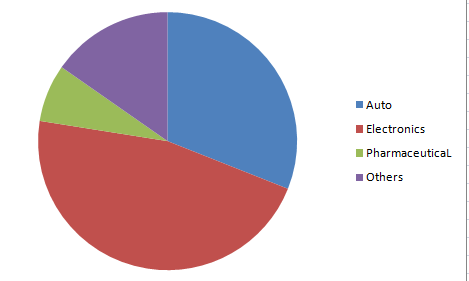From the perspective of industrial users, how do you think of the machine vision market?
Machine vision is one of the key components to realize industrial automation and factory intelligence. The first is the industry 4.0 wave sweeping the world, and the intelligentization of manufacturing will inevitably bring about the upgrading of production equipment; the second is that China’s demographic dividend advantage is gradually weakening, and manufacturers tend to replace people with machines to reduce labor costs; third is the upgrading of consumption levels, consumers The quality of products puts forward higher requirements, which makes manufacturers increase quality control. The three are interlinked, bringing new development opportunities for the machine vision market in the field of intelligent manufacturing.
Many North American machine vision manufacturers said that in China more than a decade ago, these high-end vision products were difficult to sell. In recent years, domestic manufacturers have been undergoing transformation and upgrading, and they have gradually become willing to purchase these high-end visual products. Now that the domestic machine vision technology market has increased in capacity, how do you view the current machine vision market from the perspective of industrial users?
In the industrial field, machine vision serves as the "eye" function of production equipment, solving tasks that cannot be recognized and detected by the human eye, and achieving economic benefits with high efficiency and low cost. This is the starting point and end point of the development of vision technology. Then, from the perspective of customer use, manufacturers are more inclined to high precision, high accuracy, large field of view automatic zoom detection, and rapid software introduction.
The first is the high precision and accuracy of detection. This is the most basic and direct purpose of the machine replacing the human eye. Manual inspection is prone to fatigue, resulting in poor work quality, and in the field of precision manufacturing, machine vision has an absolute advantage over human eyes. At present, the measurement and judgment of machine vision is very mature.
Some factories produce large objects, which is a greater challenge for visual inspection. In the past, two methods were used for large field of view detection. One is to cover with two code readers, and the other is to use a high-resolution camera, add a light source, a lens, and some customized software to operate. These two types of large-field inspections require professional engineers to do debugging and maintenance. From the customer's use and maintenance costs, they are not ideal, so it is difficult to carry out large-scale deployment. The DATAMAN370 series of barcode readers launched by Cognex this year are precisely to comply with the needs of customers for wide-field inspection, and have been successfully applied in PCD boards, packaging, printing and other fields.
From the perspective of the use of visual technology software, whether the developer can quickly introduce the system will determine the customer's acceptance to a certain extent. For the system, of course, the simpler the better. The use of the customer's vision system should be more inclined to "dumb" operation and development. The visual platform developed by the software company modularized many functions, such as BLOB analysis, arithmetic operations, logical operations, color matching, and other functions into multiple modules. Customers can quickly import the modules into applications according to their own needs.
Machine vision is a comprehensive technology, and its main markets are distributed in the fields of electronics manufacturing, automobile manufacturing, pharmaceuticals, food and packaging machinery. According to the report of the Prospective Research Institute, the electronics manufacturing industry accounts for 46.5% of the machine vision market, followed by the automotive industry, accounting for 31%. In addition, the penetration rate of logistics, food, packaging, printing and other industries has also increased year by year.

Machine vision downstream application ratio
From the perspective of the specific applications of machine vision, the electronics manufacturing industry is specifically used in PCB printed circuits, electronic packaging, screen printing, SMT surface mount, semiconductors and integrated circuits, reflow and wave soldering, and consumer products such as smart phones and tablets . The automobile manufacturing industry is mainly used in panel printing quality inspection and precision measurement. Food and medicine and packaging machinery mainly focus on packaging defect detection, production date detection, color recognition, and sorting. Printing machinery is mainly for printing quality inspection, printed character inspection, barcode recognition and so on.
In addition to the above industries, many traditional industries also have machine vision applications. For refined processing industries such as gold and jewelry, many times rely on people to use a magnifying glass to detect product defects with the naked eye. Furthermore, the production process of gold jewelry is still dominated by manual operations, which is not conducive to cost control, and there are many uncertain factors. In order to improve efficiency in mass production, vision technology based on deep learning is a good choice. In addition, architectural decoration is a labor-intensive industry, and the quality of engineering is often based on human factors. In the past, the acceptance of projects relied on the "master" to check whether the wall was flat, the ceiling was assembled, and the gap between doors and windows was too large. Nowadays, talents in the construction and decoration industry are facing a situation where they are not connected. It is the trend of the industry to improve the level of automation. High-end hotels, restaurants, and home decoration have extremely high quality requirements, and their market share is gradually increasing. Therefore, the acceptance of projects based on vision technology is required for the building decoration industry to move toward automation and intelligence.
 ApplicationsProcessorsFeaturesApplicationsRugged Embedded Computing
ApplicationsProcessorsFeaturesApplicationsRugged Embedded Computing IOT Logistics Gateway
IOT Logistics Gateway ProcessorsFeatures
ProcessorsFeatures Sales and SupportSales and Support
Sales and SupportSales and Support ApplicationApplication
ApplicationApplication About usAbout us
About usAbout us










